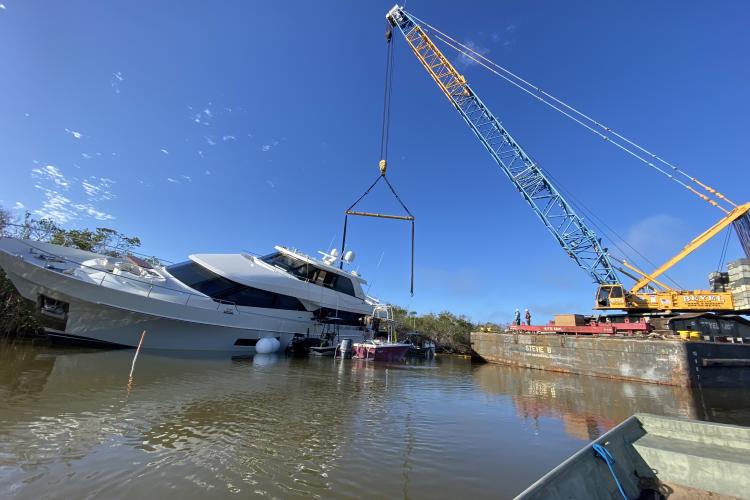The Endangered Species Act (ESA) recognizes the necessity to respond immediately to emergencies and provide expedited consultation that allows Federal agencies to complete their critical missions in a timely manner while providing the protections afforded to listed species under the ESA.
Federal action agencies who fund, permit, or carry out activities that may affect threatened or endangered species, their critical habitat, or essential fish habitat are required to consult with NOAA Fisheries regarding the potential impacts of their actions on these trust resources. Where emergency actions may affect listed species and/or their critical habitats, a Federal agency may not have the time for the administrative work required by normal consultation procedures. Emergency consultation expedites communication and allows agencies to incorporate endangered species concerns into their emergency response.
An emergency is a situation involving an act of God, disasters, casualties, national defense or security emergencies, etc., and includes response activities that must be taken to prevent imminent loss of human life or property. Predictable events, like those covered in Emergency Use Permits issued by the Environmental Protection Agency for pesticide applications, usually do not qualify as emergencies under the Section 7 regulations unless there is a significant unexpected human health risk.
Mitigation Measures and Best Management Practices
During any emergency, NOAA Fisheries' primary objective is to provide technical advice and recommendations, including Best Practices, for minimizing adverse effects to listed species and critical habitat during emergency response activities. The protection of ESA-listed species and designated critical habitat is warranted when it will not interfere with the emergency response to protect human life and property.
We strongly encourage action agencies to include applicable mitigation measures and best practices listed below in any emergency response. When initiating contact with NOAA Fisheries, please indicate which mitigation measure and best practices will be implemented during response activities.
- Grounded Vessel Response Best Practices (PDF, 5 pages)
- Floating Power Plants Mitigation Measures and Best Practices (PDF, 3 pages)
- Channel Maintenance and Dredging Mitigation Measures and Best Practices (PDF, 22 pages)
- Single Point Liquified Natural Gas Terminal Mitigation and Best Practices (PDF, 4 pages)
- Oil and Gas Pipeline Construction and Operation Mitigation Measures and Best Practices (PDF, 3 pages)
- Oil and Gas Pipeline Abandonment Mitigation Measures and Best Practices (PDF, 3 pages)
- Gas, Oil, and Fuel Handling and Loading Mitigation Measures and Best Practices (PDF, 4 pages)
Initiating Contact
During any emergency response, the Federal action agency should contact NOAA Fisheries as quickly as possible following the onset of the emergency. To begin the emergency consultation process with NOAA Fisheries Southeast Region, please provide the following information:
- What is the emergency you are responding to? Please specify the emergency you are responding to, including specific incident names when appropriate (e.g., Hurricane Ivan; grounding of the Sailing Vessel Jane; discovery of unexploded ordnance at Vero Beach).
- What is the nature of your emergency action? Please describe, briefly, the response action you are undertaking (e.g., removing collapsed sections of the I-10 Escambia Bay Bridge; prevention of oil release and salvage of the vessel; explosive ordnance disposal).
- When did the emergency occur, or, if unknown, when did you become aware of the emergency?
- Is the original source of the emergency still occurring?
- Provide location coordinates in Decimal Degrees ONLY (example lat 27.8046) of the emergency response (North latitude is assumed). Even though response efforts may occur over large areas, please identify a single point that roughly conveys where efforts will occur.
- Who should NOAA Fisheries contact with follow-up recommendations or questions? Please provide the name, email, and phone number of your agency’s Point-of-Contact for this emergency consultation.
Submit this information and consultation requests via email to nmfs.ser.emergency.consult@noaa.gov.
NOAA Fisheries Recommendations
NOAA Fisheries will provide the Federal action agency, within 2 business days, a written response, including any protective measures we recommend be implemented. The intent of these recommendations is to minimize the risk of additional harm to listed species and critical habitat from response activities and improve prospects for recovery after the emergency. NOAA Fisheries will contact the Federal agency if any additional information is required and to coordinate any needed ongoing support during complex or long-lasting response operations.
Emergency Over
Once the emergency is under control, the Federal action agency will identify any effects to listed species or critical habitat or incidental take of a species that resulted from the emergency response action. The action agency will document these effects or incidental take and describe what action the agency took to respond to the emergency and provide this information to NOAA Fisheries.
Consultation Completed
If incidental take of a listed species has occurred, the Action agency can request that NOAA Fisheries prepare an after-the-fact biological opinion to cover any incidental take that occurred during the emergency response and document the final impacts to the ESA-listed species. If no take occurred, no further consultation is required.
Questions?
For questions regarding emergency consultation processes contact Francesca Innocenti (Francesca.Innocenti@noaa.gov) for North Carolina to Texas (excluding the Florida Keys) or Helena Antoun (Helena.Antoun@noaa.gov) for the Florida Keys and the Caribbean.
Return to the Southeast Region's ESA Section 7 Interagency Consultation main page here.



